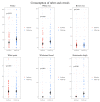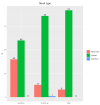Gluten-Free Diet: Nutritional Strategies to Improve Eating Habits in Children with Celiac Disease: A Prospective, Single-arm Intervention Study
- PMID: 33800620
- PMCID: PMC8065720
- DOI: 10.3390/nu13041108
Gluten-Free Diet: Nutritional Strategies to Improve Eating Habits in Children with Celiac Disease: A Prospective, Single-arm Intervention Study
Abstract
Background: Elimination of gluten-containing cereals and consumption of ultra-processed gluten-free foods might cause an unbalanced diet, deficient in fiber and rich in sugar and fat, circumstances that may predispose celiac children to chronic constipation.
Aim: to evaluate if counseling with a registered dietitian (RD) was capable of improving eating and bowel habits in a celiac pediatric population.
Methods: Dietetic, lipid profile and stool modifications were analyzed, comparing baseline assessments with those twelve months after receiving heathy eating and nutrition education sessions. At both time points, 3-day food records, a bowel habit record and a lipid panel were conducted. Calculated relative intake of macro- and micro-nutrients were compared with current recommendations by the European Food Safety Authority (EFSA). Student's paired t-test, McNemar test, Mandasky test and Pearson correlation tests were used.
Results: Seventy-two subjects (58.3% girls) with a mean (standard deviation (SD)) age of 10.2 (3.4) years were included. Baseline diets were imbalanced in macronutrient composition. Significant improvements were observed in their compliance with dietary reference values (DRVs), where 50% of the subjects met fat requirements after the education and 67% and 49% with those of carbohydrates and fiber, respectively (p < 0.001). Celiac children decreased red meat and ultra-processed foods consumption (p < 0.001) and increased fruits and vegetables intake (p < 0.001), leading to a reduction in saturated fat (p < 0.001) and sugar intake (p < 0.001). Furthermore, 92% of the patients achieved a normal bowel habit, including absence of hard stools in 80% of children constipated at baseline (p < 0.001).
Conclusions: RD-led nutrition education is able to improve eating patterns in children with celiac disease (CD).
Keywords: dietary therapy; dietitian; gluten-free diet; healthy eating; nutritional management.
Conflict of interest statement
The authors declare no conflict of interest.
Figures








Similar articles
-
Influence of nutrition education in paediatric coeliac disease: impact of the role of the registered dietitian: a prospective, single-arm intervention study.J Hum Nutr Diet. 2020 Dec;33(6):775-785. doi: 10.1111/jhn.12800. Epub 2020 Aug 12. J Hum Nutr Diet. 2020. PMID: 32790023 Clinical Trial.
-
Intakes of nutrients in Italian children with celiac disease and the role of commercially available gluten-free products.J Hum Nutr Diet. 2013 Oct;26(5):436-44. doi: 10.1111/jhn.12026. Epub 2012 Dec 17. J Hum Nutr Diet. 2013. PMID: 23252793
-
The gluten-free diet: a nutritional risk factor for adolescents with celiac disease?J Pediatr Gastroenterol Nutr. 1998 Nov;27(5):519-23. doi: 10.1097/00005176-199811000-00004. J Pediatr Gastroenterol Nutr. 1998. PMID: 9822315
-
[Simple obesity in children. A study on the role of nutritional factors].Med Wieku Rozwoj. 2006 Jan-Mar;10(1):3-191. Med Wieku Rozwoj. 2006. PMID: 16733288 Review. Polish.
-
Nutritional Imbalances in Adult Celiac Patients Following a Gluten-Free Diet.Nutrients. 2021 Aug 21;13(8):2877. doi: 10.3390/nu13082877. Nutrients. 2021. PMID: 34445038 Free PMC article. Review.
Cited by
-
Adherence to the Mediterranean Diet and Ultra-Processed Foods Consumption in a Group of Italian Patients with Celiac Disease.Nutrients. 2023 Feb 13;15(4):938. doi: 10.3390/nu15040938. Nutrients. 2023. PMID: 36839296 Free PMC article.
-
Role of Nutrition in Gastroesophageal Reflux, Irritable Bowel Syndrome, Celiac Disease, and Inflammatory Bowel Disease.Gastro Hep Adv. 2023 Jul 5;2(6):860-872. doi: 10.1016/j.gastha.2023.06.010. eCollection 2023. Gastro Hep Adv. 2023. PMID: 39130122 Free PMC article. Review.
-
Assessment of dietary patterns in celiac disease patients using factor analysis method and their relationship with dietary intakes and body mass index.BMC Nutr. 2024 Mar 6;10(1):48. doi: 10.1186/s40795-024-00849-7. BMC Nutr. 2024. PMID: 38448898 Free PMC article.
-
Study Protocol for a Controlled Trial of Nutrition Education Intervention about Celiac Disease in Primary School: ZELIAKIDE Project.Nutrients. 2024 Jan 23;16(3):338. doi: 10.3390/nu16030338. Nutrients. 2024. PMID: 38337623 Free PMC article.
-
Importance of an Ongoing Nutritional Counselling Intervention on Eating Habits of Newly Diagnosed Children with Celiac Disease.Nutrients. 2024 Jul 25;16(15):2418. doi: 10.3390/nu16152418. Nutrients. 2024. PMID: 39125299 Free PMC article.
References
Publication types
MeSH terms
LinkOut - more resources
Full Text Sources
Other Literature Sources
Medical
Miscellaneous

